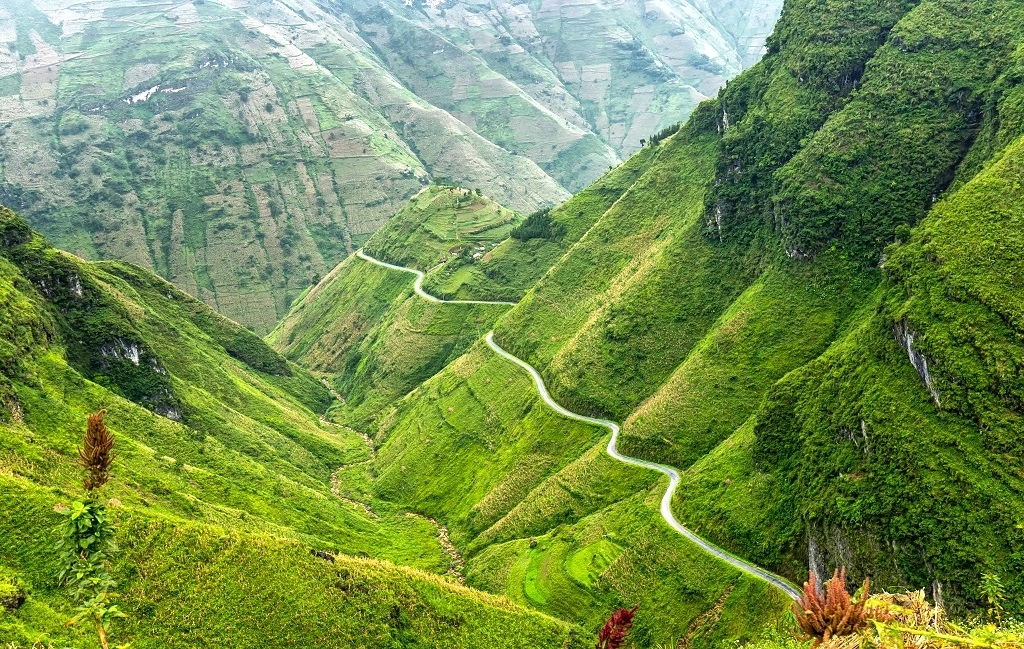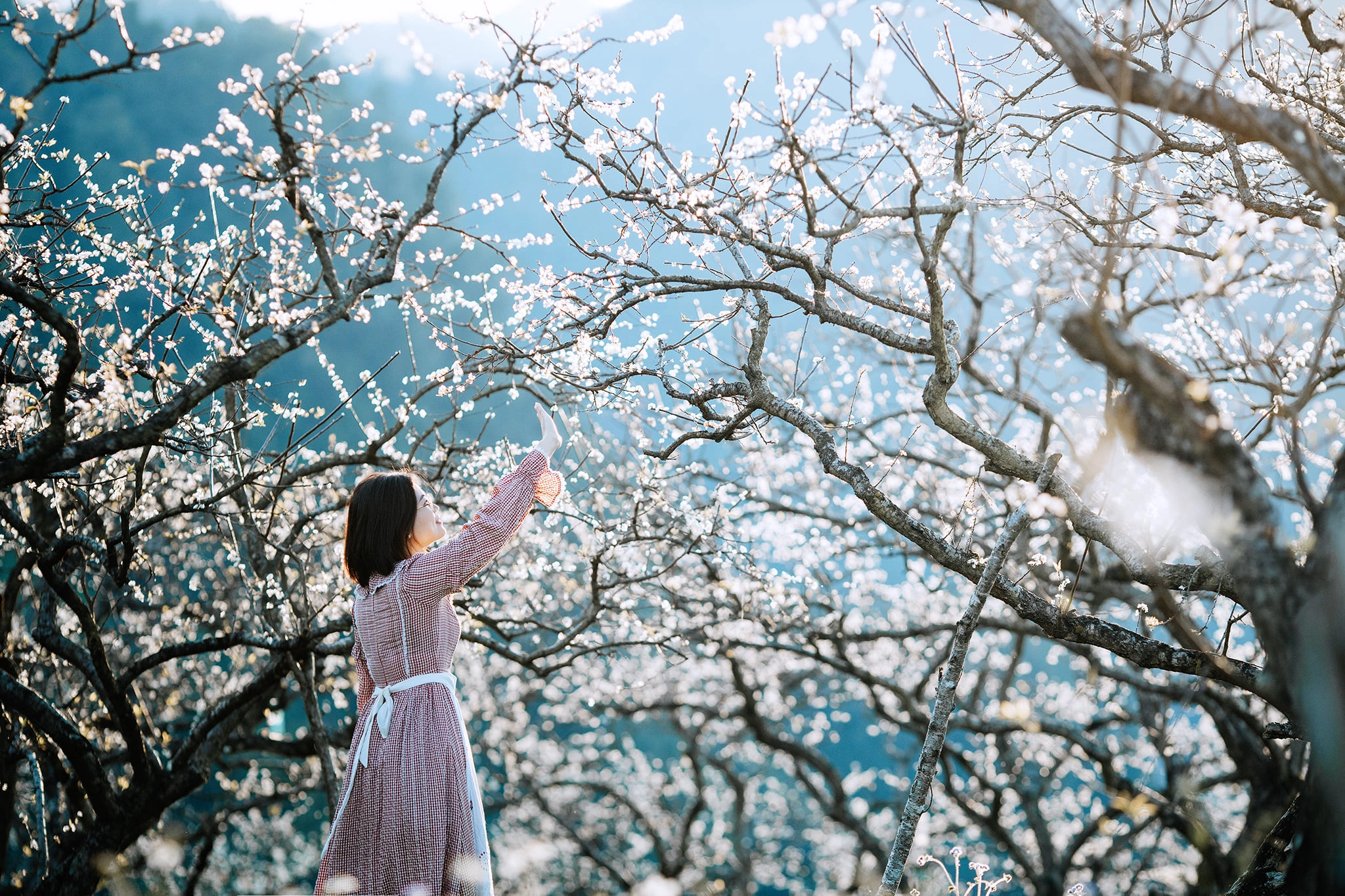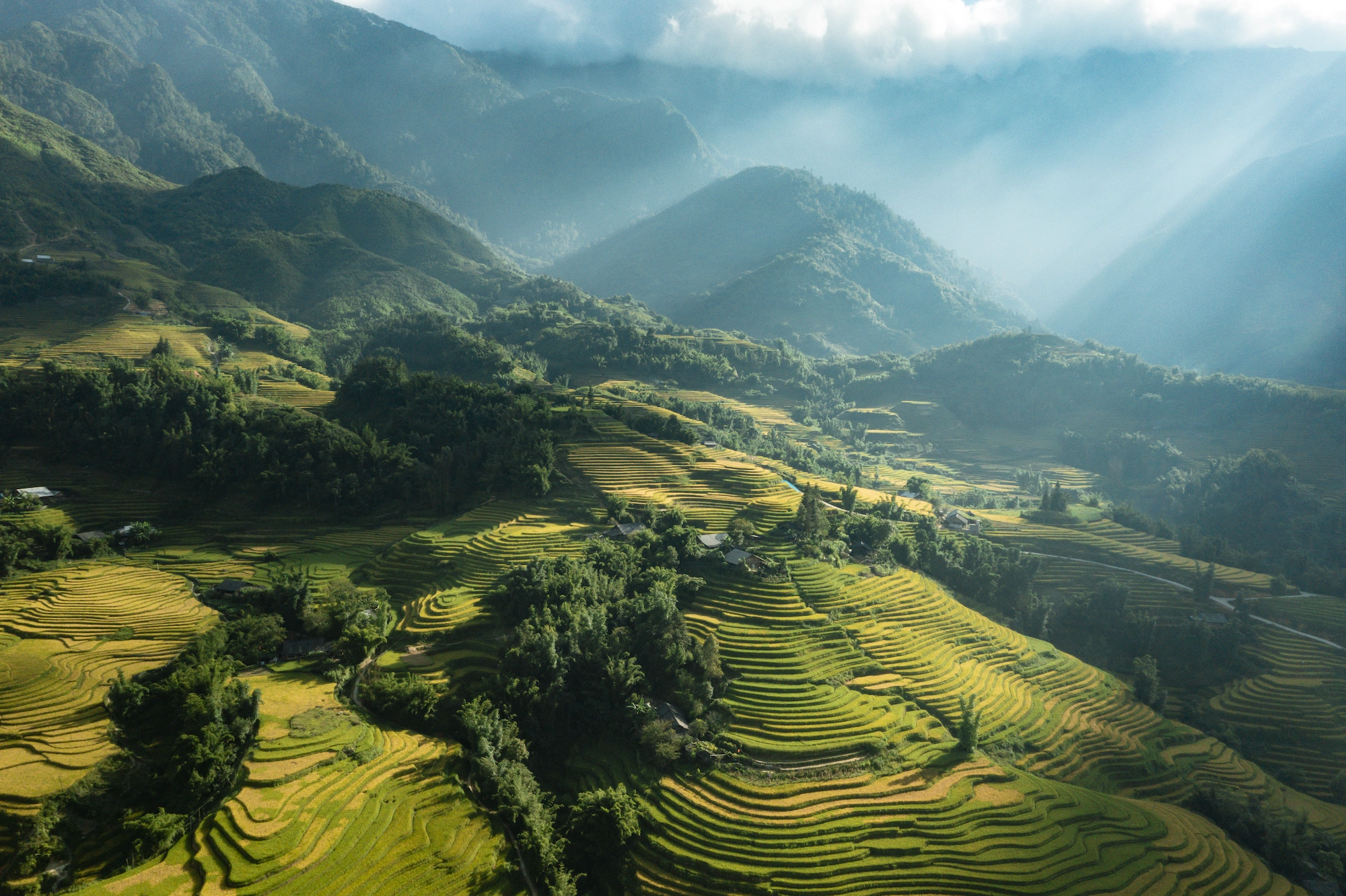
Dong Van Travel Guide A-Z: Transportation, Activities, Sightseeing, Local Cuisine
🗺️ Dong Van Travel Guide A-Z: Transportation, Activities, Sightseeing, Local Cuisine
📍 Location: Dong Van District, Ha Giang Province 🏔️ Altitude: Approximately 1,500m above sea level 🚗 Distance: 150km from Ha Giang City 🌤️ Best time: October to November (triangle flower season)
🌸 January - March (Spring):
- Pleasant temperature (10-20°C)
- Beautiful natural scenery
- Peach and plum blossoms
☀️ April - June (Summer):
- Cool weather (15-25°C)
- Ideal time for many adventure experiences
- Lush green landscapes
🍂 July - September (Autumn):
- Comfortable weather (12-22°C)
- Rice harvest season, golden landscapes
- Ideal time for photography
❄️ October - December (Winter):
- Cool (5-18°C), sometimes freezing
- Triangle flower season in full bloom
- Majestic scenery with mist
Dong Van District has two towns: Dong Van and Pho Bang, along with 17 communes including Ta Phin, Xa Phin, Pho Cao, Sung La, Van Chai, Lung Phin, and Ma Le. This is the northernmost point of Vietnam and a popular stop for tourists visiting Ha Giang, as the area’s key attractions are concentrated here. Dong Van’s terrain is quite complex, mostly consisting of rocky mountains separated by deep valleys, with an average altitude of 1,500 meters above sea level.
>> See also: Ha Giang Travel Guide
🌤️ Climate
Dong Van is located in a monsoon climate zone with distinct continental characteristics. The average annual rainfall is high, about 1,750-2,000 mm, concentrated from May to October. The dry season runs from November to April of the following year. The average annual temperature is about 20°C, dropping to 1-2°C at its coldest and reaching nearly 40°C at its hottest. Air humidity is about 84%. Dong Van also experiences salt fog, and occasionally snow in winter.
🚗 Transportation
The best way to travel to Dong Van is by motorcycle or car due to the complex terrain and numerous mountain passes.
Transportation Options
You can use several modes of transportation to reach Dong Van:
- 🏍️ Motorcycle/Personal Car: Flexible but requires mountain driving experience, travel time about 3-5 hours
- 🚌 Bus: From Ha Giang bus station, ticket price about 150,000 - 250,000 VND/person
- 🚐 Tourist Vehicle: Premium service, price about 200,000 - 350,000 VND/person
Directions
🚗 From Ha Giang: About 3-5 hours
From Ha Giang City:
- 🚗 Main Route: Travel along National Highway 4C
- 🔄 Time: About 3-5 hours, depending on transportation
Important Notes:
- 🛣️ Terrain: Quite complex terrain, mostly rocky mountains separated by valleys
- ⛽ Gas Stations: Available along the route but should fill up before going up the mountain passes
- 📱 Phone Signal: Decreases at higher altitudes, download offline maps beforehand
- 🌦️ Weather: Roads become slippery when wet, best to travel early morning or late afternoon
Transportation in Dong Van
- 🚴 Motorcycle Rental: About 100,000 VND/day
- 🚖 Local Taxi: About 100,000 - 200,000 VND/trip
- 🚌 Local Bus: Affordable, fixed routes to tourist attractions

Nho Que River flows through Dong Van and Meo Vac before joining the Gam River in Cao Bang. Photo: Xuan Phuong
🏨 Accommodation
Dong Van offers diverse accommodation options from local homestays to standard hotels, with prices ranging from 100,000 - 1,000,000 VND/night.
Accommodation Types
Book rooms 1-2 days in advance, especially during peak season (October to November).
🏠 Homestay (100,000 - 500,000 VND/night)
- 🏡 Experience: Live with locals, learn about H’Mong and Dao ethnic cultures
- 💰 Price: Suitable for small groups and couples
- 🎯 Notable Homestays:
- Hagiang Holic
- Plum Homestay
- Dong Van Cliffside House
- Dong Van H’Mong Homestay
- Dong Van B&B
- Khoi Home
🏩 Hotels (400,000 - 1,000,000 VND/night)
- 🛏️ Amenities: Private rooms, indoor bathrooms, hot and cold water
- 🍽️ Service: Most offer breakfast service
- 🎯 Notable Hotels:
- Hoa Cuong Hotel
- Hoang Van
- Hoang Ngoc
- Ma Pi Leng Hotel
🎯 Attractions
Plan to spend 2-3 days to fully explore Dong Van, including famous tourist attractions and local cultural experiences.
🏛️ Dong Van Old Town
- Location: Center of Dong Van town
- Features: Located in the core of the Dong Van Global Geopark
- History: Formed over 100 years ago
Located in the core of the Dong Van Global Geopark, Dong Van Old Town is a must-visit destination for tourists. The old town is located in the center of Dong Van town and was formed over 100 years ago. Originally, this area was just a wild valley with sparse population. By the end of the 19th century, the town gradually formed. From above, Dong Van Old Town consists of three rows of houses arranged in a U-shape, covered with traditional tiles, including residential and commercial areas that, while not large, have unique characteristics of the rocky plateau region.
When visiting, don’t miss the Old Town Coffee Shop located at the corner of Dong Van central market, in a house over 100 years old built against the mountain.
>> See also: Over 100-year-old coffee shop in Dong Van
🏔️ Tham Ma Pass
- Location: On National Highway 4C, between Yen Minh and Dong Van districts
- Features: One of the most dangerous roads in northern Vietnam
- Length: 5 km with 9 winding turns
Tham Ma Pass is a mountain road located on National Highway 4C, between Yen Minh and Dong Van districts. This pass is known as one of the most dangerous roads in northern Vietnam, stretching 5 km with 9 winding turns. For this reason, many people enjoy conquering Tham Ma Pass. When stopping here, where there’s a beautiful photo spot, you’ll have the opportunity to hear many legends about this pass.
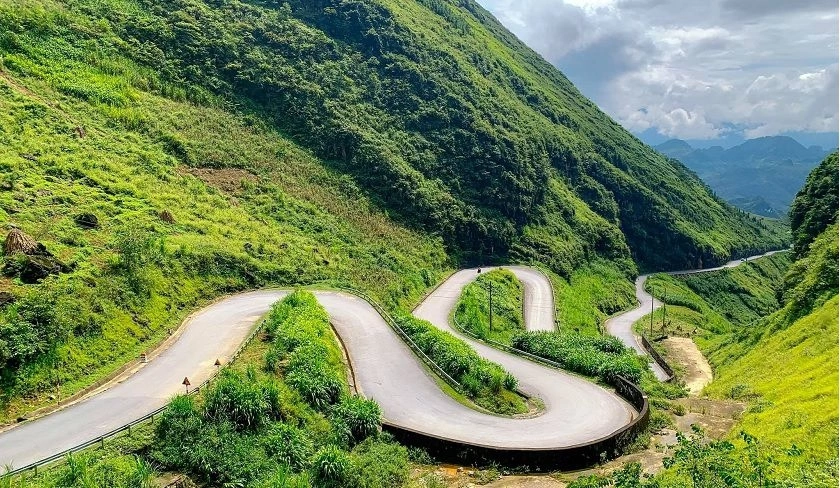
Tham Ma Pass. Photo: Dulich24
🏰 King’s Palace Complex
- Location: Sa Phin Commune, 13 km from Dong Van town center
- History: Built at the beginning of the 20th century
- Architecture: Modeled after Qing Dynasty (China) architecture
The King’s Palace Complex in Sa Phin Commune was built at the beginning of the 20th century, modeled after Qing Dynasty (China) architecture, according to Ha Giang Province’s official portal. The house took 8 years to complete, built on a 1,120 m2 plot of land. The palace has a turtle shape with tall sa mộc trees. Two concentric walls built with stone blocks have loopholes and guard towers. The palace has three stilt houses. The main house faces the gate, with two auxiliary houses parallel and perpendicular to the main house. All three houses, from columns, beams, floors, walls, to roofs, are made of precious wood.
The King’s Palace is located next to National Highway 4C on the road from Ha Giang City to Dong Van, 13 km from Dong Van town center. In 1993, the King’s Palace Complex was recognized as a national architectural and artistic relic.
🌊 Nho Que River
- Length: The Vietnamese section is 46 km long
- Features: Water has an emerald green color most of the year
- Activities: Scenic boat rides or kayaking
Nho Que River originates from Yunnan, China, flowing in a northwest-southeast direction through Dong Van and Meo Vac districts in Ha Giang Province before joining the Gam River in Cao Bang. The Vietnamese section of the river is 46 km long, from Lung Cu through Tu San gorge and then along Ma Pi Leng Pass. A distinctive feature of the river is that its water has an emerald green color most of the year. In recent years, local travel companies offer scenic boat rides or kayaking services for tourists. Rental prices range from 50,000 to 150,000 VND per boat, depending on the type.

A section of Nho Que River. Photo: Xuan Phuong
Note: To reach the boat dock, tourists must navigate winding roads. It’s recommended to hire a local guide with good driving skills and familiarity with the route.
🇻🇳 Lung Cu National Flag Tower
- Altitude: 1,470 m above sea level
- Location: Lung Cu Peak (Dragon Mountain Peak), Lung Cu Commune
- History: Inaugurated on September 25, 2010, over 30 m tall, octagonal shape
The flag tower is located at Lung Cu Peak, also known as Dragon Mountain Peak, 1,470 meters above sea level, in Lung Cu Commune. The flag tower is about 3.3 km from Vietnam’s northernmost point as the crow flies. The flag tower has a long history, having undergone multiple restorations and renovations. It currently has an octagonal shape, over 30 meters tall, and was inaugurated on September 25, 2010. At the top is a 9-meter pole flying the Vietnamese national flag covering 54 m2. From the top of the flag tower, you can see two lakes on either side of the mountain that never dry up, called “dragon eye lakes.” The flag tower is 24 km from Dong Van town.
🌸 Sung La Triangle Flower Field
- Location: Sung La Commune, about 20 km from Dong Van town
- Best time: October to November
- Features: Fairy tale-like scenery under rocky cliffs
About 20 km from Dong Van town, Sung La Commune has fairy tale-like scenery under rocky cliffs. The H’Mong people in Sung La often plant buckwheat on high hillsides, making this one of the most beautiful flower viewing spots in Ha Giang. The ideal time is from October to November.

Triangle flower season in Sung La. Photo: Cao Anh Tuan
🏠 Pao’s House
- Location: Sung La Commune
- History: Built in 1947, used as a filming location for the movie “Pao’s Story”
- Entrance fee: 10,000 VND/person
Also located in Sung La Commune, “Pao’s House” is actually a local resident’s house built in 1947 and used as a filming location for the movie “Pao’s Story.” The house features traditional H’Mong architecture of the rocky plateau region, enclosed on all four sides with a central courtyard. The front yard is paved with stone, surrounded by plum, apricot, and peach trees - characteristic plants of the region. The house has beautiful architecture, and the surrounding landscape becomes even more beautiful during flower season, making it a popular attraction for tourists.
This attraction charges 10,000 VND per tourist.

Pao’s House from a distance. Photo: Hoang The Anh
🏘️ Pho Bang Town
- Population: Chinese and H’Mong communities with over 500 residents
- Features: Maintains simple, peaceful, and ancient charm
- Location: About 5 km from the highway, near the Vietnam-China border
Unlike other places, Pho Bang gives visitors a sense that time moves slowly. This is home to Chinese and H’Mong communities with over 500 residents. The town stands out for maintaining its simple, peaceful, and ancient charm. Due to its remote location, Pho Bang is somewhat isolated and less known. To enter the town, one must travel nearly 5 km from the highway, approaching the Vietnam-China border, where only rocky cliffs exist.
🛍️ Pho Cao Weekly Market
- Location: 25 km from Dong Van town center
- Frequency: Opens every 6 days
- Time: From early morning until noon
Located 25 km from Dong Van town center, Pho Cao Weekly Market opens every 6 days, usually running from early morning until noon. Pho Cao Market is not only a place for buying and selling local goods and products but also a venue for cultural exchange among 17 ethnic groups in the area. All market sessions are very lively. People wear their most beautiful dresses, bringing everything from chickens to pigs, dresses, scarves, sharpened knives, to freshly picked vegetables from their gardens.
🍜 Local Cuisine
Food in Dong Van represents typical Ha Giang cuisine, found throughout the province. However, in Dong Van, tourists have many reputable places to choose from.
Local Specialties
🍲 Au Tau Porridge
Au Tau porridge with distinctive flavor and nutritional value.
Au Tau porridge is a typical dish of Ha Giang. Ingredients for making porridge include au tau tubers, rice, pork, sausage, eggs, vegetables, and other items. Au tau is a familiar plant to locals, also known as au tau or thu o, grown extensively in Ha Giang’s highlands. Fresh au tau tubers are poisonous, but through local processing, they become delicious food. Au tau is also a precious medicinal herb with cold-relief, muscle-relaxing, fatigue-reducing, and sleep-promoting properties. To make porridge, au tau tubers must be soaked in concentrated rice washing water for about 10 hours, then simmered for many more hours until the tubers become soft and mushy, eliminating the poison.
Recommended addresses: Moc Mien Porridge, porridge shop in Dong Van market.
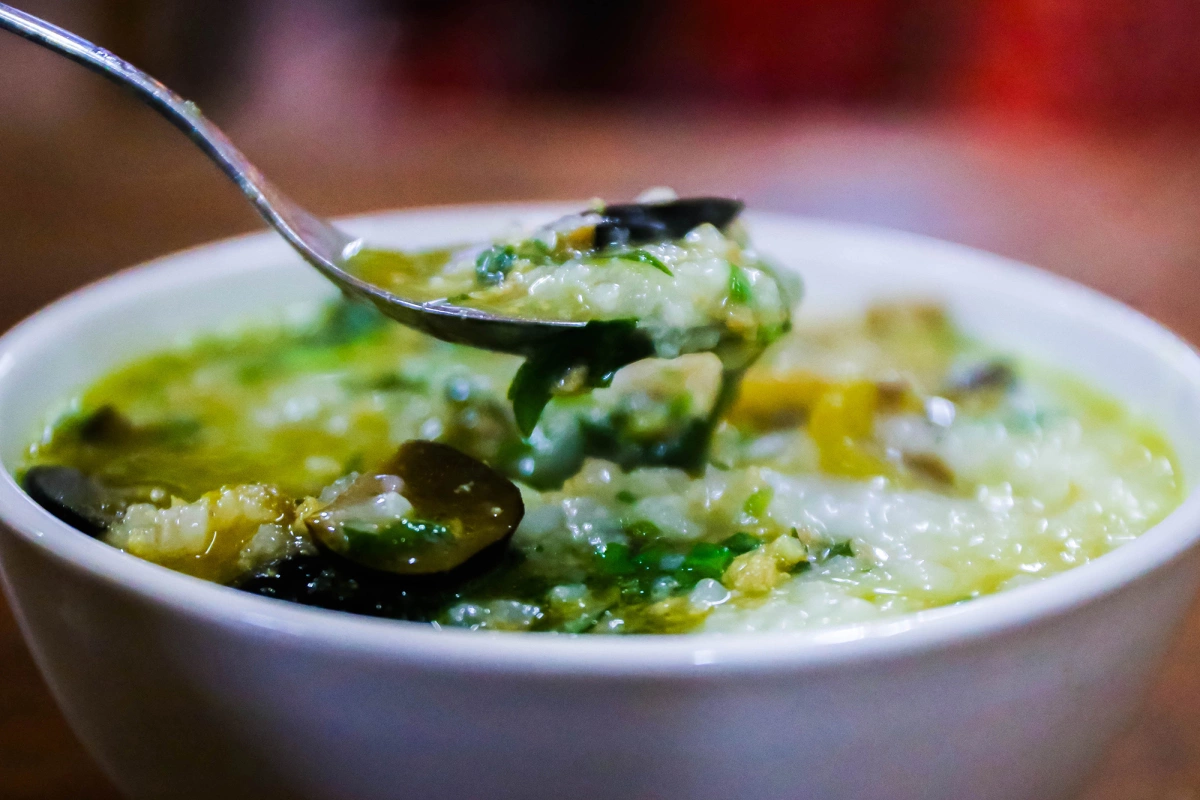
Typical Au Tau porridge of Ha Giang. Photo: Xuan Phuong
🥢 Rice Noodle Rolls
Rice noodle rolls with fragrant meat filling typical of the highlands.
Ingredients for this dish include rice flour, meat, wood ear mushrooms, bones, sausages, and seasonings. The flour is soaked overnight to soften, then mixed with seasonings. When customers arrive, the cook pours the batter onto a hot tray on-site. After about 3 minutes, the noodles are cooked and rolled with prepared meat and wood ear mushrooms, cut short and placed on a plate, topped with fried onions and herbs. Unlike rice noodle rolls dipped in fish sauce in many regions, Ha Giang rice noodle rolls are eaten with broth. The broth is simmered with pork bones, giving it a sweet and light taste. According to locals, due to the cold mountain climate in the morning, people eat rice noodle rolls with soup to stay warm.
Recommended addresses: Mrs. Ha’s Rice Noodle Rolls, Ms. Lieu’s Rice Noodle Rolls.
🍰 Buckwheat Cake
Buckwheat cake made from local buckwheat plants.
The cake is made from buckwheat flower seeds with high nutritional value. To make the cake, after each harvest season, people dry the seeds, using some to create yeast and the rest to make buckwheat cakes. The seeds are ground into powder, then kneaded into dough and shaped into flat, round cakes with a diameter of more than a handspan. After shaping, the cakes are steamed and grilled over charcoal, best eaten hot with a light sweet taste.
The cakes are sold at markets, roadside stalls, and near tourist areas.
🍲 Thang Den
Thang Den with round glutinous rice balls and ginger-sweetened water.
Among Ha Giang’s snacks, Thang Den cannot be overlooked. Sold widely in Dong Van Old Town or at weekly markets, Thang Den, though just a “snack,” has quite a special appeal. A bowl of Thang Den consists of round glutinous rice balls boiled and sweetened ginger water, with added black sesame or crushed roasted peanuts when eating.
🍚 Men Men
Men Men with pure corn flour, crispy and delicious.
Men Men is a simple dish closely associated with local life. In the rocky plateau region where rice cannot be cultivated, corn rice (or Men Men) is the main food of the H’Mong people. Initially, Men Men was just a daily meal for locals, gradually sold more at weekly markets to introduce culinary culture. To make Men Men, corn is thoroughly dried and processed through multiple steps such as pounding, removing residue, and steaming. Men Men has a fragrant corn flavor and can be eaten with soup.
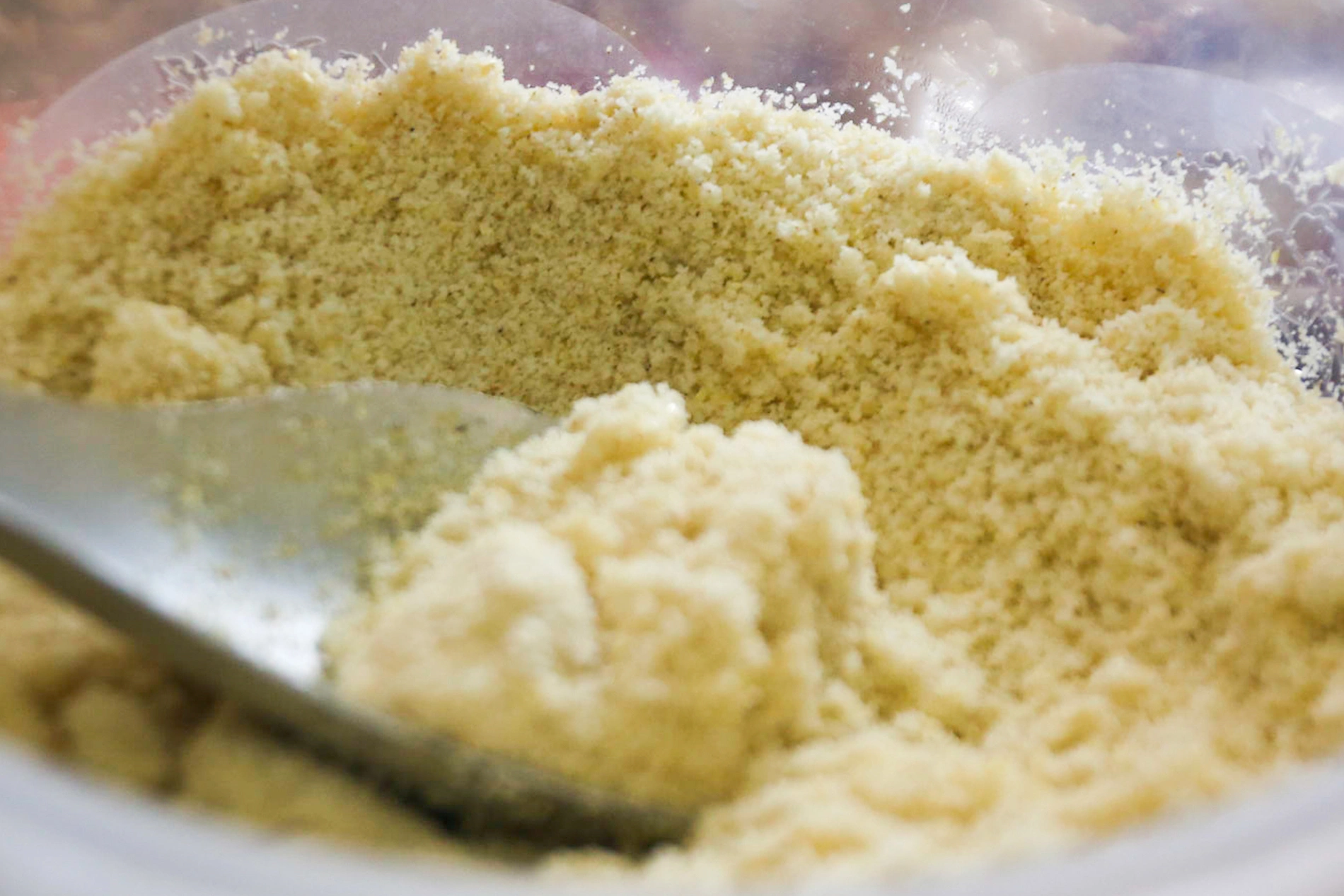
Men Men. Photo: Xuan Phuong
☕ Cuc Bac Coffee
Cuc Bac Coffee Shop with traditional house architecture reflecting Lo Lo ethnic culture.
Cuc Bac Coffee Shop is located in Lo Lo Chai Village, a small village right at the foot of Lung Cu Flag Tower, less than 1 km from the Vietnam-China border, in Lung Cu Commune. The shop was built by Mr. Ogura Yasushy, a Japanese person who lived in Vietnam for many years and especially loves Ha Giang. The shop features traditional house architecture reflecting Lo Lo ethnic culture, rustic and vintage with stone fences, traditional tile roofs, earth walls, and wooden gates. What’s special is that the shop offers not only traditional Vietnamese phin coffee but also Japanese green tea matcha.
📷 Dong Van Photo Album
Below is a collection of beautiful photos of Dong Van for your reference:
🌄 Dong Van Scenery
Dong Van Scenery




🏰 King’s Palace Complex
King's Palace Complex




🌸 Flower Fields and Villages
Flower Fields and Villages




🛍️ Weekly Market and Cuisine
Weekly Market and Cuisine






☕ Coffee and Specialties
Coffee and Specialties





🏨 Accommodation in Dong Van
Accommodation in Dong Van


⚠️ Notes
Weather Conditions
- 🌤️ Triangle flower season: October-November, stunning scenery with triangle flower hills
- 📅 Winter: December-February, can be cold and freezing
- 🌅 Photography angles: Determine sunrise direction for the best photo angles
Safety and Transportation
- 🚫 Limitations: Avoid Tham Ma Pass at night or during heavy rain
- 👥 Group travel: Don’t travel in overly large groups on narrow roads
- 💰 Pricing: Always ask and negotiate when taking motorcycle taxis
Costs and Booking
- 💵 Costs: Approximately 1.5 - 3 million VND/person for 2 days 1 night
- 📅 Booking: Book early during holidays as accommodations often sell out
- 🚶 Capacity: Dong Van can serve hundreds of tourists simultaneously but should avoid peak times
Dong Van is an ideal destination for those who love majestic natural scenery and want to experience unique local culture. With beautiful scenery year-round and diverse attractions, Dong Van promises unforgettable memories for tourists.
Prepare thoroughly and plan carefully for a complete trip to this “rocky plateau paradise.”
📍 Important note: Bring warm clothes, rain gear, and appropriate sports shoes as mountain weather changes quickly and terrain can be challenging.
Author: Tam Anh

